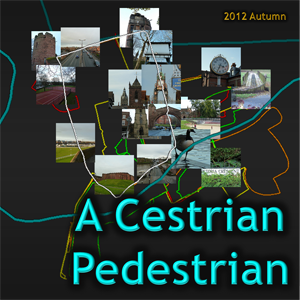 Article for 2012 Dec 16
Article for 2012 Dec 16
Part of the “A Cestrian Pedestrian” series.
2012
Appendix

For more information about Chester and its attractions, please consult ChesterWalls.info, VisitChester.com, EnglishHeritage.org.uk, and/or ChesterTourist.com. The first of these is particularly informative.
There is an appendix to this appendix, a table of photographs relating to the eight city gates.
The photos used to illustrate these articles may not have been taken on each day. Clicking on each image should display the Flickr page, on which is the actual date taken.
Dec 16 Sun
I circuited the walls last week, but didn’t venture off the walls so to take photos of the gates and walls themselves. This significant omission was rectified today. Now I have at least four photos for every one of the eight gates, looking inside and outside the walls from each gate, and looking at each gate from inside and outside the walls.
I started at the Bridgegate, for which I have all four photos, so I came east, to the Newgate, for which I also have all four photos. Then I came off the walls, as the Newgate is only an abandoned amphitheatre and an empty church away from the Grosvenor Park.
 The Grosvenor Park is where the arch from the old Shipgate was moved in 1831 (a large jail was built in its place, near the castle).
The Grosvenor Park is where the arch from the old Shipgate was moved in 1831 (a large jail was built in its place, near the castle).
This archway, a Grade-II-listed building, was built by the Normans, and - as you may expect from its name and its former location beside the river - used to be used for transporting goods from the boats on the Dee to the city.
 Then I returned to the walls, stopping at Eastgate (the subject of more photographs by me than dunnocks in my garden). I stopped because the walls there were impassable due to maintenance work. I had forgotten that. But I’ve remembered this: the Eastgate is not the furthest east of Chester’s gates. The Newgate is, forty metres east (and two hundred metres south). Of course, if you consider the Shipgate as still a gate, that’s the easternmost gate, 342 metres further east.
Then I returned to the walls, stopping at Eastgate (the subject of more photographs by me than dunnocks in my garden). I stopped because the walls there were impassable due to maintenance work. I had forgotten that. But I’ve remembered this: the Eastgate is not the furthest east of Chester’s gates. The Newgate is, forty metres east (and two hundred metres south). Of course, if you consider the Shipgate as still a gate, that’s the easternmost gate, 342 metres further east.
 I’ll backtrack to my walk along the walls. Indeed, after the Eastgate I backtracked to the Newgate, then I walked along the walls to the Bridgegate, then I got distracted by some really rather beautiful geese, then I came past where the Shipgate used to be (I didn’t take photos there because I don’t know the exact former location). Then I continued along the walls, crossed Grosvenor Road, and continued along the walls, along the walls.
I’ll backtrack to my walk along the walls. Indeed, after the Eastgate I backtracked to the Newgate, then I walked along the walls to the Bridgegate, then I got distracted by some really rather beautiful geese, then I came past where the Shipgate used to be (I didn’t take photos there because I don’t know the exact former location). Then I continued along the walls, crossed Grosvenor Road, and continued along the walls, along the walls.
 Finally, I arrived at the gate that I had planned to arrive at (if the Eastgate/Kaleyard Gate section had been passable) at the end of my trip, the Watergate.
Finally, I arrived at the gate that I had planned to arrive at (if the Eastgate/Kaleyard Gate section had been passable) at the end of my trip, the Watergate.
At the Watergate, I came off the walls at the steps on the city side. I was thus able to get my shot of the Watergate from inside the walls. Then I returned to the walls.
 Getting the shot of the Watergate from outside the walls was more difficult, but more fun. I continued along the walls and found steps beyond Bonewaldesthorne’s Tower. These steps led outside the city, so I came down them, and walked to the Water Tower. They’ve a bowling-green there! And football pitches, where kids were playing.
Getting the shot of the Watergate from outside the walls was more difficult, but more fun. I continued along the walls and found steps beyond Bonewaldesthorne’s Tower. These steps led outside the city, so I came down them, and walked to the Water Tower. They’ve a bowling-green there! And football pitches, where kids were playing.
(The Water Tower is so named because of the canal and river nearby; in olden days the river was wider, and covered the race-course. Indeed, the “ee” of “Roodee” comes from “eye”, meaning “island”, as there was a small island in the middle with a “rood” - a crucifix - crucially fixed atop it.)
 I continued. I passed under the railway bridge over New Crane Street, and the Watergate was visible again. I got the shots, tried not to get run over. (Cars are lethal.)
I continued. I passed under the railway bridge over New Crane Street, and the Watergate was visible again. I got the shots, tried not to get run over. (Cars are lethal.)
At the Watergate, I came back onto the walls. Turns out there is a pavement to the road that goes under the Watergate (that New Crane Street).
 I re-walked the walls at that north-west corner, and hurried to St Martin’s Gate. It’s quite an impressive (if grey) viaduct they have there. The nicest bit of Sixties architecture in the city, I think. The name of “St Martin’s” comes from St Martin’s Church, which was destroyed when St Martin’s Way was constructed. No-one in my family remembers it.
I re-walked the walls at that north-west corner, and hurried to St Martin’s Gate. It’s quite an impressive (if grey) viaduct they have there. The nicest bit of Sixties architecture in the city, I think. The name of “St Martin’s” comes from St Martin’s Church, which was destroyed when St Martin’s Way was constructed. No-one in my family remembers it.
 Though I wasn’t near home, I was nearly home. Only two more gates to photograph. And two minutes until dusk. At least the Northgate was lit up; it looked quite nice with the sodium light and helium sky. (I talk in falsetto when I’m too tired to write coherently. I should probably stop writing later.)
Though I wasn’t near home, I was nearly home. Only two more gates to photograph. And two minutes until dusk. At least the Northgate was lit up; it looked quite nice with the sodium light and helium sky. (I talk in falsetto when I’m too tired to write coherently. I should probably stop writing later.)
 I continued along the walls, passing the Phoenix Tower and stopping at the Kaleyard Gate, the narrowest of Chester’s gates. I retook several photos from that area, and in exploring different angles I found - prepare yourself for this - the Kaleyards Designated Pigeon Feeding Area. I got distracted quite a while by this dovecote and its flocking residents.
I continued along the walls, passing the Phoenix Tower and stopping at the Kaleyard Gate, the narrowest of Chester’s gates. I retook several photos from that area, and in exploring different angles I found - prepare yourself for this - the Kaleyards Designated Pigeon Feeding Area. I got distracted quite a while by this dovecote and its flocking residents.
When it was too dark for photographing, I went home, and tried to formulate a nice ending for this article. Too tired to think of one, I settled for this one, and settled into a nice warm bed, to dream of pigeons and doves and resurrecting Romans, and other fantasies.